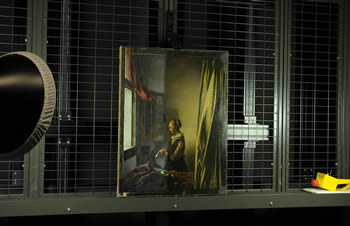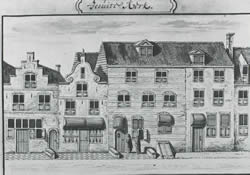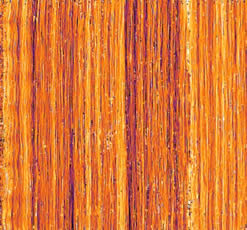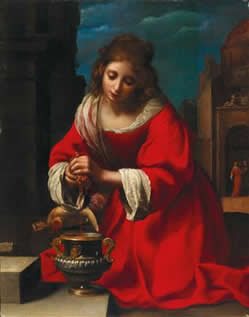Essential Vermeer Newsletter no. 39
December 2017
December 2017
Click here to access this newsletter as a SIMPLE TEXT document.
Please remember the Essential Vermeer when you change your email address!
IN BRIEF :
exhibitions:
1. Vermeer's Woman in Blue Reading a Letter in Australia
2. A Young Woman Seated at the Virginals Exhibited in Shanghai
restoration and upcoming publication:
3. Vermeer's Girl Reading a Letter at an Open Window in Restoration
4. New Publication and Technical Examination of Vermeer's Mistress and Maid in the Frick Collection
scholarly article:
5. Detailed Study of Vermeer's Neighborhood with House-by-House Database
6. The Puzzle Solved? Notes on the Early Provenance of Vermeer's The Art of Painting
on the web:
7. Vermeer Canvas Database at the RDK Website
8. New High-Resolution Image of Vermeer's Christ in the House of Martha and Mary at the National Gallery of Scotland Website
in the news:
8. St. Praxedis by Felice Ficherelli sold at the Dorotheum
1.

Rembrandt and the Dutch Golden Age: Masterpieces from the Rijksmuseum
Art Gallery of New South Wales, Sydney
Nov 11, 2017–Feb 18, 2018
https://www.artgallery.nsw.gov.au/exhibitions/rembrandt/
Rembrandt and the Dutch Golden Age presents a richly unfolding panorama of Dutch society during an era of unparalleled wealth, power and cultural confidence. In the Dutch Golden Age, the art of painting flourished as never before. Artists observed the beauty of the visible world, transforming it with exceptional skill into vivid and compelling paintings. Their subjects ranged from intense portraits and dramatic seascapes to tranquil scenes of domestic life and careful studies of fruit and flowers. Included in the exhibition is Vermeer's masterpiece Woman in Blue Reading a Letter.
catalogue:
Rembrandt and the Dutch Golden Age: Masterpieces from the Rijksmuseum
https://www.artgallery.nsw.gov.au/shop/item/9781741741322/
by Gerdien Wuestman
hardback – 212 pages – $39.95
2.

Rembrandt, Vermeer and Hals in the Dutch Golden Age: Masterpieces from The Leiden Collection
Long Museum, West Bund, Shanghai Shi, China
September 23, 2017–February 25, 2018
http://thelongmuseum.org/en/exhibition/overview/51dfps
from the museum website:
The Leiden Collection and Long Museum (West Bund) are staging an exhibition of works from the Leiden Collection, the largest and most important collection of paintings from the Dutch Golden Age in private hands. The exhibition will feature 78 works, making it the largest showing of seventeenth-century Dutch art ever presented in China. The selections will comprise 12 works by Rembrandt van Rijn, one painting attributed to Vermeer, and two portrait paintings by Frans Hals, as well as masterpieces by other artists from the period.
The ways in which artists responded to one another, and to tradition, are central to the themes and scope of the exhibition. These relationships are explored most centrally through the remarkable breadth and depth of artistic innovation in Leiden, as demonstrated by Rembrandt van Rijn and Jan Lievens and the Leiden fine painters, Gerrit Dou and Frans van Mieris. The exhibition further explores the work of important Dutch and Flemish artists in other artistic centers, including works by Frans Hals, Hendrick ter Brugghen, Jan Steen, Carel Fabritius, Peter Paul Rubens, and A Young Woman Seated at the Virginals, attributed to Vermeer.
3.
https://gemaeldegalerie.skd.museum/en/research/vermeer/

In March of 2017, the Dresden Gemäldegalerie Alte Meister removed Vermeer's early masterpiece Girl Reading a Letter at an Open Window from the permanent exhibition in order to initiate the restoration of the picture. The procedure will accompanied by an expert commission of five restorers and scientists from Dresden, Amsterdam, Copenhagen and Vienna.
The restoration is taking place in the paintings conservation department at the Staatliche Kunstsammlungen Dresden and is being performed by painting conservator Dr. Christoph Schölzel. Accompanying the restoration is a research project about the painting, carried out in cooperation with the archaeometry laboratory at the Hochschule für Bildende Künste Dresden, the Doerner-Institut at the Bayerische Staatsgemäldesammlungen München, the Rijksmuseum Amsterdam and the National Gallery in London.
Vermeer's Girl Reading a Letter at an Open Window will be presented to the public when the renovation of the Gemäldegalerie in the Semperbau is complete and the museum reopens in 2019. It will be a highlight of the new permanent exhibition.
Images of the restoration process are available on the special page at the Gemäldegalerie website.
4.

https://www.frick.org/press/frick_publish_new_series_books_frick_diptychs
The Frick Collection has announced a new series of books entitled Frick Diptychs. Each publication will illuminate a single important work from the museum's collection by juxtaposing an in-depth essay by a curator with a contribution from a contemporary cultural figure. Connecting the Old Masters with the masters of today, the series is designed to spark a dialogue in essay form between creative spirits and art historians, promising fresh insights for the expert and general public alike. The first volume is dedicated to Hans Holbein's portrait of Sir Thomas More, one of the Frick's most iconic paintings. A subsequent volume will be devoted to Vermeer's remarkable Mistress and Maid, one of the three Vermeer paintings owned by the Frick Collection. The Vermeer book will feature an essay by Margaret Iacono, Associate Research Curator at the Frick, and a piece by film director, writer and producer James Ivory, known for movies including The Golden Bowl, The Remains of the Day, and A Room with a View. The series is in association with D Giles Ltd., London. The volume on Vermeer is expected to be published in mid to late 2018.
In connection with the new series of books, Vermeer's Mistress and Maid is temporarily off view because it is undergoing technical analysis at the Metropolitan Museum. The painting will probably be back on view no sooner than late January, 2018. The results of the analysis will be shared thereafter. The other two paintings by Vermeer, Officer and Laughing Girl and Girl Interrupted in her Music, will remain on view as usual.
The Frick Diptychs will be sold at the Museum Shop of the Frick, online at shopfrick.org, or by phone 212.547.6848.
5.

Johannes Vermeer and his Neighbours v1.0 (PDF)
by Hans G. Slager
http://www.essentialvermeer.com/history/neighbours-slager.pdf
It has been universally accepted that the mature Johannes Vermeer lived on Oude Langendijk in Delft, situated amidst the Catholic living quarter known as the Papist Corner. Following John Michael Montias' seminal study of Vermeer's life and extended family, Vermeer and His Milieu: A Web of Social History, published in 1989, however, no further research has been conducted in regards to either the location of the artist's living quarters or the neighborhood in which he lived. Persuaded that a more accurate reconstruction of the Papist corner was possible, and that neighbors may influence the lives of its individual members, the independent researcher Hans Slager has examined afresh the circumstances of those who lived in the vicinity of Vermeer in the hopes of uncovering not only undiscovered information but clues for further research.
This new study of the Papist Corner investigates a wealth of housing and genealogical data in the light of house sales, taxation records, legal issues and other events, at times mundane, but nevertheless vital to the success of a more exhaustive reconstruction. Slager's analysis suggests that Vermeer's traditionally held residence on the Oude Langendijk may, in fact, be erroneous, and that his real residence may still physically exist.
Aside from the Papist neighborhood, other issues are addressed, such as the fate of the Mechelen inn, Van Ruijven's patronage and Van Leeuwenhoek's presumed friendship with Vermeer. Lastly, an analysis of the name linked to the two prominently pictured heraldic stems that appear on the two stained-glass windows in Vermeer's The Glass of Wine and The Girl with a Wine Glass reveals possible links to various Leiden fijnschilder painters. Ties between some of Vermeer's principal clients are also described in detail.
Necessarily, a study containing such a significant amount of data demands a selective rather than a story-telling approach so that all data is organized within a house-by-house scheme. Moreover, data is published in full in order to serve as a springboard for future investigation—there may still be more information on Vermeer, hopefully complimenting Montias' volume. Johannes Vermeer and his Neighbors may be read by art historians, Delft historians and Vermeer lay enthusiasts alike.
6.

The Puzzle Solved? Notes on the Early Provenance of Vermeer's The Art of Painting
by Erik de Visser
http://www.essentialvermeer.com/history/provenance-art-of-painting.html
The Puzzle Solved? Notes on the Early Provenance of Vermeer's The Art of Painting sets out in well-considered detail the high probability that Vermeer's masterpiece did indeed, as suspected by some scholars, come to Vienna in 1745 at the time that Gerard van Swieten (1700–1772) took up his position as Empress Maria Theresa's personal physician. In addition, the paper shows that the Dutch doctor could not have come into possession of this painting if, in the immediate years following Vermeer's death (1675), the artist's wife, Catharina Bolnes, and his mother-in-law, Maria Thins, had failed to keep Vermeer's masterpiece safe in Delft. As will be shown, a chain of events set in motion by Maria Thins resulted in the painting leaving the Vermeer family to eventually come into the ownership of two Van Swieten generations.
7.

Counting Vermeer: Using Weave Maps to Study Vermeer's Canvases
http://countingvermeer.rkdmonographs.nl/
Counting Vermeer: Using Weave Maps to Study Vermeer's Canvases features a new type of scientific examination of paintings: computer-generated 'weave maps'. These weave maps provide information about threads and weave patterns with such precision that scholars can compare the character of the canvas supports of different paintings. This knowledge can help determine, for example, whether canvas supports were made from the same bolt of cloth. As a consequence, weave maps are an extremely useful tool for assessing questions of dating, pendant relationships, and even authenticity. This volume, the result of collaborative efforts by conservators, art historians, scientists and computer specialists, and produced through the initiative of C. Richard Johnson, Jr., demonstrates the ways in which the study of weave maps has helped inform our understanding of a number of paintings by Johannes Vermeer.
This RKD Studies publication is the culmination of a decade of personal scholarship following the founding of the Thread Count Automation Project (TCAP) in 2007. A timeline of the first half-dozen years of TCAP activities can be viewed at http://people.ece.cornell.edu/johnson/tcap.html. Weave maps and matches were introduced and applied by participants in this project, who appear as co-authors.
8.
https://www.nationalgalleries.org/art-and-artists/5539/christ-house-martha-and-mary

After a recent and elegant remake of their website, the National Gallery of Scotland offers a high-resolution of their early Vermeer, Christ in the House of Martha and Mary. By clicking on the "zoom" link, the navigator can explore some of the picture's exquisite details, including the pensive head of the seated Mary, one of the finest, yet atypical, passages of the painter's early efforts. At maximum magnification the sensitivity of the painter's hand as well as the richness of the painting's surface are as evident as possible without being in front of the original. Of course, the dimensions, the strength of color and infinite variety of substances of the great masterworks we admire will be never captured by any digital imaging technique, but the possibly to have at our fingertips images whose qualities were previously unimaginable is something belongs to one of the many technical miracles of our age that we would be better not to forget. Unfortunately, the image cannot be integrally downloaded but I suspect that it is only a matter of time that a technically inclined Vermeer devotee, perha ps myself, will have the patience to copy each section of the painting at maximum resolution and paste them together with utmost care to form the complete image.
9.
 Saint Praxedis
Saint Praxedis
As the Dorotheum auction of October 17, 2017 demonstrated, old master paintings are apparently always in season when numerous bidders vied to acquire a selection of paintings at this well-attended event, including a St. Praxedis by the Florentine painter Felice Ficherelli.
According to the Dorotheum sales catalogue, this version of the Saint Praxedis appears to be the prime version of Ficherelli's composition, which is primarily known through two other variants. One is another autograph version by Ficherelli, which was formerly in the collection of Carlo del Bravo in Florence, and now in a private collection in Ferrara. The other is a copy that is tied by some art historians to Vermeer. It was initially endorsed as an authentic work by the young Vermeer by Michael Kitson, an art historian at the University of London, and later confirmed by Arthur K. Wheelock Jr. of the National Gallery in Washington D.C.
A technical analysis and infrared photographs have revealed several pentimenti, demonstrating that the present work was modified during its execution. It was originally intended to have a much more ornate architectural structure on the right and a Tuscan column on the left, which in the finished painting is a simple square block. The beheaded martyr also appears to have been originally conceived slightly differently. The fact that both the Ferrara version and Vermeer's copy follow the details of the finished present painting make it highly likely that this Saint Praxedis is the original version of the composition. A drawing conserved at the Uffizi also demonstrates that Ficherelli experimented with different compositional schemes for this work.
The Ficherelli was auctioned by the Viennese auction house for the notable price of $415,000 by an undisclosed art enthusiast. The work was estimated to sell between $177,500 to $237,000. The copy of the painting presumed to be by the hand of the young Vermeer was sold at Christie's on July, 8 2014, for $8,450,000.
If you discover a  or anything else that isn't working as it should be, I'd love to hear it! Please write me at: jonathanjanson@essentialvermeer.com
or anything else that isn't working as it should be, I'd love to hear it! Please write me at: jonathanjanson@essentialvermeer.com